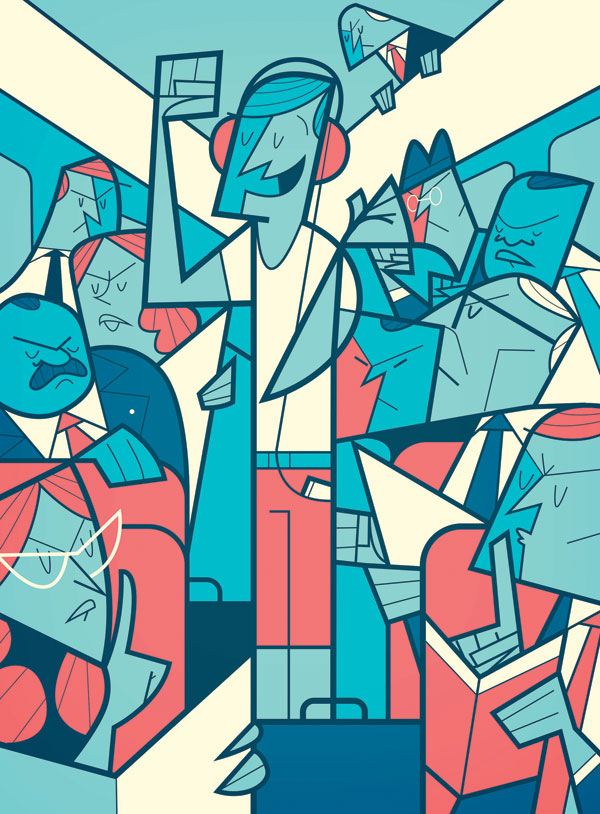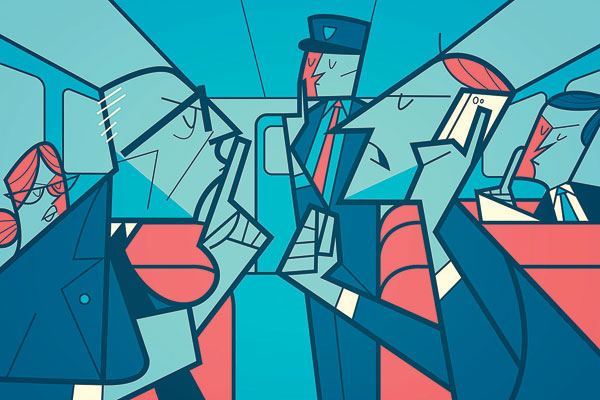
Two suburban commuters glare at one another across a Metra quiet car like a couple of gunslingers in a dusty saloon.
And then, in a blink, it’s on. With relative ease, the larger man, a white-haired fellow, pins the smaller guy to his seat and loudly scolds him for his transgressions, which allegedly include … talking. He eases up after a few seconds, and the diminutive gentleman pops back up, his rage unabated.
“I sit on the Board of Trade. I will cut you in half!” he snarls, a threat that became the title of a YouTube video that’s garnered more than 200,000 views since 2013.
Go see for yourself, if you must. It’s easy to find but difficult to watch, mostly because it’s just really pathetic to see two grown men flail around like children in a playground skirmish. But it also serves as an absurd reminder: Raising your voice above a whisper can have consequences.
Second car from the front.
Second from the rear.
These are the quiet cars on most Metra trains, which transport commuters to and from the city each day. Inspired by the popularity of Amtrak’s Quiet Car program and introduced in 2011, they are marked by small blue signs featuring an androgynous profile in the classic shushing position: index finger extended in front of lips.
Technically speaking, you don’t have to be completely silent. Conversations are “discouraged,” and if absolutely necessary should be kept short and held in “subdued voices” during rush hour on weekdays, according to Metra. But try defending your right to subdued conversation while getting shushed by a rabid pack of moonlighting librarians from hell. That’s not a winnable battle, friends.
Other rules: no calling your boo, your side piece, your bookie, or your stockbroker. And for Chrissakes, keep the Steely Dan in your headphones low enough so others don’t hear it.
Passengers themselves largely enforce the rules (or their interpretation thereof), just as Metra officials expected when the program was launched. Physical confrontations, such as the one in that infamous YouTube video, are extremely rare, says Metra spokesman Michael Gillis. Most passengers opt for more civilized death stares and clench-jawed rebukes. Conductors also enforce the rules—but from my own experience riding the Union Pacific North line for the past five years, I’d have to say that varies quite a bit.
Never a shusher, at times a shushee, I’ve witnessed terse exchanges. Recently, I observed a 30-ish male hipster silence an older woman on the phone by making a vicious slashing motion across his ear. The train hadn’t even left the station.
Public shaming is at the very essence of quiet car enforcement. And the more egregious the offense, the harsher the silencing. Yak loudly on your phone? Well, you’re going to get barked at by someone who’s even more of a prick than you. Sometimes a simple glare does the trick. On occasion, the whole lot of us will wordlessly bore holes into some poor sap’s head with our eyeballs in passive-aggressive fury—a team strategy with mixed results.
Like taking any form of public transportation, riding the Metra quiet car can be a fascinating and ultimately discouraging study in race, gender, and class. The Union Pacific North line chugs through some of the wealthiest burbs in the Chicago area: Wilmette, Kenilworth, Winnetka, Glencoe, Highland Park, and Lake Forest. Some of the most aggressive quiet car enforcers I’ve seen reside in these towns. Mostly white men of a certain age—many of them attorneys, executives, and traders—this is the ruling class. They are men used to giving orders and getting what they want. They shush like it’s their God-given right.
I’ve yet to witness a black or Latino passenger turn to a loudmouthed white guy and tell him to stick a cork in it. It’s less common for women to silence men. My point here: Anyone can shush anyone, but not everyone feels comfortable wielding that power.
Dick Kates, a 75-year-old attorney and former Winnetka trustee who’s taken the train for almost 40 years, can recall when smoking was permitted on the Metra and coffee was served in a designated area. He knows the quiet car etiquette as well as anyone. Craggy-faced and at times cantankerous, Kates could single-handedly obliterate a municipal proposal or propel it forward at the height of his powers.
I had him pegged as a shusher for sure. And I was right. At the end of a busy day of lawyering, Kates likes to collect his thoughts in silence.
But to my surprise, Kates also fessed up to being shushed on several occasions. “The only problem is when you see a friend you haven’t seen in a very long time and it’s, ‘Hello, how are you’—and whoops!” Kates says with a sheepish grin.

I had that experience recently when a friend visited me from California. We boarded the train with a couple of tall, sweaty beers—another fine Metra tradition—and a ton of catching up to do. But a WASPy-looking gentleman sensed trouble right away, peered over his spectacles, and informed us we were in a quiet car. His tone was polite yet condescending; his manner bespoke a steely gentility forged, I imagine, from laying people off and outsourcing jobs to India.
For a hot second, I wanted to tell him to fuck right off.
Instead, my friend and I apologized, took our giant beers, and shuffled meekly to another car.
But for every time I’ve felt oppressed by the sanctity of the quiet car, I’ve had another hundred experiences when I’ve been grateful for the luxury. On our way to the city for a wedding not long ago, my wife and I tried to converse in a nonquiet car. But a couple of 20-something dudes bounded on the train at Kenilworth and commenced guffawing and cussing loudly over videos on their phones, spewing all kinds of idiotic invective not appropriate for a public setting.
I stewed in my seat, wishing we were on a quiet car, mentally preparing myself for the type of confrontation with strangers I usually seek to avoid. But to my everlasting joy, a girl who couldn’t have been more than 10 paused from eating her apple and asked them to “lower their volume.” And the knuckleheads complied. It was a victory for all of humanity.
Though not all conductors enforce the rules, one of my favorites is a real hard-ass. I once saw him shush two passengers, leave for a moment, circle back, silence them again, and then, clearly exasperated, take to the loudspeaker to chide the entire train. I envisioned a Cersei from Game of Thrones walk of shame for the offenders as they exited and was prepared to hurl my beer can at them, but both men apologized and that was that.
The conductor, a black man in his 40s with a commanding glare when he’s pissed, sighed like Sisyphus when I asked him about his daily ordeal. There are times when he decides it’s not worth the effort, he admits, such as when Ravinia concertgoers pack the train with their lawn chairs and picnic baskets.
“I have a slight issue enforcing the rule because it is public transportation,” he says. “Every once in a while, you have to remind people, but once you do, they apologize.”
Nicholas Matejcak, 32, and Pia Opulencia, 30, boldly whispered to one another as the train pulled into Ogilvie one recent morning. I watched with admiration, waiting for someone to eviscerate them. When I asked about their courageous act, they both appeared genuinely contrite. They hadn’t realized they were in a quiet car. “I’m a little ashamed, I have to be honest,” Matejcak said.
Since Metra introduced the quiet cars, the entire train has become more subdued. One theory: People lose track of which car they’re on, don’t want to be publicly humiliated, and therefore keep their traps shut at all times. The ubiquity of smartphones must also be factored in. Take away the quiet car rules and people would still rather play Pokémon Go than talk to one another. Such are the times that we live in.
There is also great comfort in dead air. On any given morning, sleepy-eyed passengers in freshly starched shirts, still smelling of shampoo and perfume, sip coffee while hunched over phones, tablets, laptops, and newspapers (in order of prevalence: The Wall Street Journal, the Chicago Tribune, The New York Times, the salmon-colored Financial Times, and, rarest of animals, the Chicago Sun-Times).
The wealthy and the poor, men and women of all races, we sit together in silent communion, bracing for the challenges that lie ahead. The verdant leaves turn brilliant orange and red, the autumn drizzle gives way to snow, the damp spring yields to long summer days and the incessant chirping of cicadas. Each person carries their own burdens through it all. The city comes into view. We gather our things. We go to work.
Last summer, a close friend of mine was killed when he walked into a busy street in Arlington, Virginia, and was struck by two cars. He was 36. For a full week after his death, I couldn’t stop crying. My grief consumed me. Several mornings on my way to work, I openly wept on the train, a seemingly never-ending stream of tears coursing down my face.
And no one on the quiet car tried to console me. No well-intentioned person said “There, there” and patted my knee. No one said “He’s in a better place now” and all the other lies we tell ourselves. There was only silence, and it sounded just right.



Comments are closed.